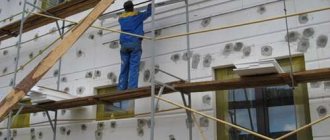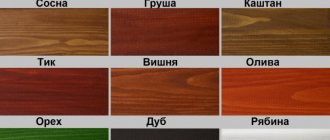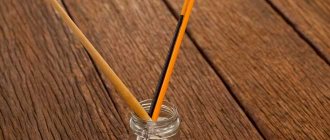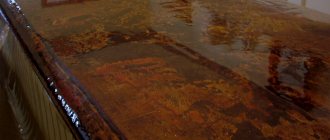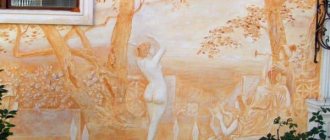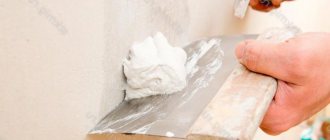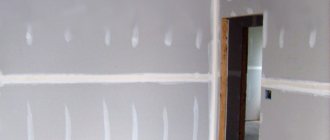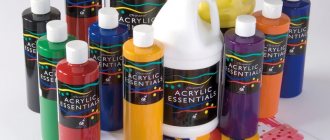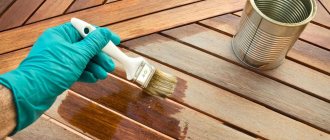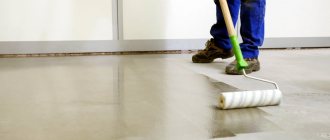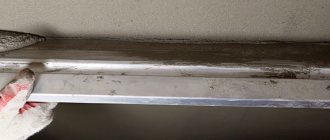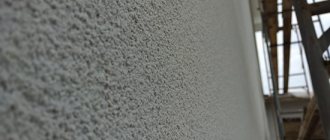According to statistics and technical studies, approximately 15-20% of heat leaves the room through the ceiling, and residents of apartments or houses have to spend more money on heating costs in the cold season. Therefore, installing a heat-insulating layer is the right decision in this situation. For example, insulating the ceiling with polystyrene foam, which will help keep the room warm, can be done independently.
Insulating the ceiling with foam plastic from inside the room
Why do you need to insulate the ceiling?
If even in a constantly heated room on winter nights it is cold and dank, there are drafts across the floor, and mild colds among residents are commonplace, one might say, a habit, then it’s time to think about insulating the rooms, fortunately, now, in the era of advanced technologies, arrange this kind of thing is not difficult. You can insulate the walls, floor, and you can also insulate the ceiling or attic space (for more details: “How to insulate the attic of a private house”).
For some reason, many do not think about such an important thing as insulating the ceiling, believing that the percentage of warm air that escapes through it is insignificant, insignificant, but, if you remember for a moment the school physics course, what is positionally higher in the room: warm or cold air? And, if the ceiling is not insulated, there is no doubt where the heat goes - everything goes upstairs, to the ceiling, and through the ceiling even higher, to the street.
Even if the owner is absolutely sure that air will not escape through the ceiling (for example, the apartment is on the first floor), he still sometimes decides to insulate the ceiling, since such work is required in cases where the owner decides to increase the living space of the apartment and combine the room and a balcony. When designing balconies, no one thinks about such a thing as thermal insulation, so you have to do the insulation of the ceiling on the balcony yourself. Otherwise, cold will quickly penetrate the room. When combining a balcony with a room, thermal insulation of the ceiling is simply necessary!
PPS or EPPS
The starting raw material for the materials is polystyrene. The final product can vary greatly in density, hardness and structure. This is explained by the plate production technology:
- Foaming . Expanded polystyrene is characterized by lower weight due to the high air content in the pores and granules. The advantage is the low price, the disadvantage is that it retains heat worse with the same thickness of the slab.
- Extrusion . EPPS has less moisture-absorbing ability and higher density, strength and hardness. With identical sheet thickness, the thermal conductivity is lower. Against the background of the advantages, only one disadvantage stands out in the group of materials - high cost.
Craftsmen also note the low adhesion of extruded insulation due to the dense and smooth surface. To improve the situation, the boards are passed with a float or a needle roller (with metal spikes) to bend the drywall. Also, such products are characterized by a stepped shape of the mounting edges. This is a practical approach from manufacturers, thanks to which there are no cold bridges and the joints between individual sheets are strengthened.
Production line for extruded polystyrene foam Source ros-tenders.ru
Why foam plastic?
There are many methods and materials for ceiling insulation.
A good solution to the problem is to insulate the ceiling with polystyrene foam, a lightweight, inexpensive material that is used everywhere. Polystyrene foam is a universal material used, including for thermal insulation, of high quality, with sufficient thermal insulation properties.
It will take little time to insulate the ceiling with foam plastic, since the procedure is quite easy.
Polystyrene foam consists of foamed plastic masses, the main volume of which is occupied by gas, which determines the low density and lightness of the material, high heat and sound insulation properties. This solution is truly ingenious, and, like all ingenious things, simple. After all, many centuries ago people knew that air is the best insulation there can be, and they “insulated” their homes by organizing specially designed attic spaces with small windows designed to regulate the temperature. If you pick up any photo of old buildings, you will see that they have gable roofs - the fact is that the snow that lingers on the roof is also a good insulator. Sometimes the attic was additionally insulated with straw.
Thanks to its composition, as well as manufacturing technologies, polystyrene foam is durable, inaccessible to rodents and insects, and withstands mechanical stress and negative environmental factors, in particular, it is not susceptible to mold and is not susceptible to rotting.
The advantage is that, despite the fact that polystyrene foam is not a natural material, it is absolutely non-toxic, which cannot be said about the same cheap but extremely dangerous glass wool. In addition, due to the fact that foam plastic is both light and durable, installation work will be possible even for a beginner in such matters. Even a non-professional can insulate the ceiling with polystyrene foam, since the installation technology is quite simple.
As already mentioned, polystyrene foam is cheap, easy to use and at the same time effective. If you do the math, ceiling insulation work with polystyrene foam is the most economical when compared with glass wool or one of the most popular materials - mineral fiber. Despite the fact that polystyrene foam is not as environmentally friendly as mineral wool, it is absolutely safe for humans. So often apartment owners don’t even have a question about what to use for thermal insulation - they are confident in the qualities of polystyrene foam as insulation. By the way, not only the ceiling, but sometimes the walls are insulated with polystyrene foam.
Another convenient thing about polystyrene foam is that work with it can be carried out even in the room where people already live, without disturbing the existing situation in the house.
Compound
*
The styrene content in foreign-made material is 0.02%. This indicates that the product is harmless. When choosing such a heat insulator, high-quality and safe insulation will be ensured.
An increased temperature is the main negative factor that leads to the release of toxic substances.
Polystyrene foam can be harmful in the following situations:
- Manufacturing technology was not followed during production. This leads to an increase in styrene content to 0.05%.
- Safety regulations were violated.
- Thermal insulation material is of poor quality.
It is also recommended to insulate the room with foam only from the outside.
How to carry out thermal insulation
Typically, work on installing thermal insulation is carried out on the outside of the ceiling, the one that goes into the attic, but for apartment residents it is possible to install thermal insulation on the inside of the ceiling.
Before you begin thermal insulation work, you need to purchase material, and even earlier, calculate its quantity. First you need to multiply the length of the room by the width and get the area. Polystyrene foam is laid in a layer of up to five centimeters. Sometimes additional materials are used to increase thermal insulation. Thus, the price of the work will depend on the cost and quantity of purchased material.
Also, before insulating the ceiling, it is necessary to clear the space for work: wash the ceiling, remove peeling whitewash, etc. If electrical work is required in the house, it must be completed before the ceiling is insulated. The surface of the ceiling must be smooth, all roughness must be corrected before work. Sometimes the ceiling, in addition to everything else, is treated with an antiseptic.
It is important to remember the room temperature when carrying out work. It is advisable to carry out work in the warm season, then the fastenings will occur faster and more reliably.
Some use polystyrene foam to insulate the ceiling, some use it as an additional layer of protection. The methods below work for both cases.
There are several ways to insulate a ceiling with polystyrene foam.
Causes of condensation
If, after insulation with polystyrene foam it drips from the ceiling , the thermal insulation is made poorly: the low surface temperature collides with steam and warm air rising upward, resulting in the formation of droplets of moisture that settle on the coating.
Drops appear when steam cannot escape, and the higher the humidity in the room, the lower the dew point . The formation of condensation leads to the appearance of mold and fungi and deterioration of thermal insulation.
The most common causes of condensation can be:
- ill-conceived ventilation design;
- lack of an insulating layer or its incomplete protection;
- incorrect placement of insulating layers;
- poor-quality insulation, which leads to freezing of the ceiling covering;
- with temperature changes resulting from different insulation in different areas.
Temperature changes can occur especially often:
- in the cellars on the ceiling;
- in detached garages and sheds;
- on balconies and loggias;
- in poorly ventilated areas;
- when insulating roofs with a large slope, where waterproofing or insulation can roll down, forming cold areas.
How to prevent condensation
To prevent condensation, you must:
- think through the ventilation ducts and air gap in the insulation layer correctly;
- when purchasing, do not skimp on the quality of insulation, waterproofing, vapor barrier;
- when purchasing a premises, pay attention to the design of the ventilation system and the consistency of its operation;
- determine the indicator of importance in the room: at levels above 40%, condensation formation is the norm.
If there is condensation, what can you do?
If there are already deficiencies in thermal insulation, the process of eliminating them is quite labor-intensive:
- insulate the finished coating from the cold ceiling: insulate with mineral wool, cover with expanded clay, apply a layer of brick chips, lay foam insulation;
- you should check the condition of the insulation: disassemble the insulation cake and carefully examine whether there are any breaks or damage, as well as whether there is water absorption;
- if moisture has penetrated to the inner layers of the finish, you need to clear the surface up to the main ceiling (concrete surface), dry the ceiling using a hair dryer, then replace the insulation.
In order for condensation to flow down, it is necessary to create an inclined surface . Depending on the location of the slope, a water drain is adjusted to the outside, under which a container is placed to collect water. Near single buildings, grooves are installed through which water flows into the soil.
To install an inclined condensate drain on the ceiling, you will need: polyethylene film material with a size equal to the area of the ceiling, sheets of galvanized iron, and plastic pipes.
Frame insulation
The method of frame ceiling insulation is that before the work the frame is also created. The materials can be different - wood, aluminum, something else - but it all depends only on the owner and the expected cost of the work. The most durable frame is considered to be aluminum.
How to insulate a ceiling with foam plastic using frames? In order to insulate the ceiling using a frame method, it is necessary to lay profiles along and across the flow. The profiles should be carefully secured using screws and dowels. The foam must be cut exactly to the size of the openings and secured with screws or glue. The foam joints must be filled with polyurethane foam. If the work is not carried out airtightly, the effect of thermal insulation will be significantly reduced.
The last stage of frame insulation is the installation of plasterboard sheets. The sheets are fixed to the frame, and foam is additionally fixed. Afterwards, the fastening points are covered with mesh and puttied. After the putty has dried, work on processing and decorating the ceiling is carried out.
Fixation by fungi
Installation of insulation on mushroom dowels can be used as an independent fastening, or as an additional fixation, for example, if foam plastic boards are laid on concrete using facade glue.
The only limitation is the drilling depth of the concrete slab. For reliable retention, four points per slab are sufficient; the distance between the fungi must be at least 50 cm. The drilling depth of the ceiling is limited to 30 mm.
Craftsmen advise that in order to prevent the material from crumbling, burn holes in the foam board with a hot rod in advance, without using a drill or a drill. The concrete surface must be primed.
Adhesive insulation
Adhesive insulation is faster and cheaper than frame insulation. You can even save on the glue itself and buy putty or tile adhesive instead.
The method involves gluing the foam to the ceiling without additional fastenings.
The ceiling should be thoroughly coated with the adhesive mixture and the glue should be allowed to dry, and only then work on fixing the foam should continue. The technology is simple: you need to apply glue to the foam and to a section of the ceiling, and then press the insulation tightly to the ceiling. This way the entire ceiling is gradually covered. For secure fastening, you can use umbrella dowels. The joints of the foam and the cracks are either covered with polyurethane foam or coated with glue.
Afterwards, a reinforcing solution is applied to the foam plastic in an even layer in several layers. Each subsequent layer is applied only after the previous one has completely dried.
Foam insulation, detailed video:
Advantages of insulating material
Let's take a closer look at the list of advantages of foam insulation, which were briefly mentioned above.
- The vapor permeability and hygroscopicity of polystyrene foam is virtually zero. This allows you to avoid laying a layer of waterproofing. This is the opinion of experts. For greater reliability, you can seal the seams between fragments of insulation using tape or polyurethane foam.
- The thermal insulation layer made from this building material does not lose its properties and does not lose density even after several years, unlike, for example, glass wool.
- A thirty-centimeter layer of polystyrene foam will retain heat more effectively than a layer of mineral wool of the same thickness.
So is it worth insulating the ceiling with polystyrene foam?
So, the answer to the question of whether it is possible to insulate the ceiling with polystyrene foam has been given unequivocally - it is possible and necessary!
Thanks to the insulation of the ceiling, the temperature in the house will become much more comfortable, which is important: no one wants to freeze in their own home. If the residents feel a chill even in the fall, there are constantly dank drafts in the apartment, and children constantly catch colds due to the unfavorable home climate, it’s time to think about insulating the apartment and start with the simplest part of the work - insulating the ceiling.
Insulating the ceiling with polystyrene foam is a simple but useful procedure. In addition, the cost of the material - polystyrene foam - is low, and the quality of thermal insulation is sufficient for moderate latitudes. If you are thinking about what inexpensive material to choose for thermal insulation, you can safely choose polystyrene foam.
Fastening to concrete and brick walls
Often, to insulate concrete and brick walls, a special sheathing is made that holds foam plastic slabs. Unfortunately, it is not always possible to install it, and in addition, additional costs arise. In practice, other fastening methods are in demand.
- Using adhesive.
This method has its own peculiarities. Firstly, individual components of the adhesive can destroy the foam, and secondly, not every stickiness of the adhesive composition will bind the foam to concrete and brick.
The insulation boards are fastened in a certain sequence:
the surface is leveled, then dirt and oil deposits are removed from it;
The glue components are connected according to the instructions. The resulting composition should not contain water, then it will not come off for a long time;
the adhesive is placed on the slab in separate sections so that there is space for air to escape;
the insulation is pressed and held.
- Using dowels.
To fasten the slab, its center and corners are selected. The joints are treated with sealants for better thermal insulation.
The slabs in the bottom row are attached first. Deformation gaps are left between all the plates, which ensure the stability of the coating during environmental temperature changes.
- Using “liquid nails” adhesive.
The composition is characterized by high heat resistance and moisture resistance. It has features of use:
to protect against the toxic component of the glue, you must use special gloves;
the adhesive is applied only at individual points;
Hardening time is no more than 30 minutes.
- Using adhesive foam.
This method is characterized by simple installation, good adhesion to concrete and brick, and low cost.
When using foam, the surface does not need to be primed. It is enough to clean and moisten it.
The foam or wall is treated with an adhesive composition. After a short period of curing, the slabs are laid in a checkerboard pattern.
Best answers
La Nochka:
Are there any bars for foam plastic? Attach the bars (or guides) to the ceiling, insulation between them (at least glue polystyrene foam), and cover them with plasterboard (according to fire regulations, 2 layers are needed). Since in the “+” corridor, a vapor barrier is not needed.
Robert Witsup:
You will still have to install an electric heated floor on the kitchen and bath floors. a floor without a heat source will not be warm. polystyrene foam will reduce heat loss from the apartment. GVL is probably not worth it. it is heavy and may fall off. glue a cement mixture over the insulation with mesh. cut and paint. it will be easier this way. Styrofoam and polystyrene are the same to me. The price of polystyrene foam is three times less (probably) and the thermal conductivity is certainly not three times worse than that of polystyrene.
Wind:
otvet.mail /question/172676484
Alexander Ulitkin:
Your option is quite correct. If the polystyrene is 50mm, then this will be enough for insulation.
Attaching to wood
Polystyrene foam is attached to wood in different ways.
- It has long been known that wood must “breathe”, otherwise rot will appear. Only thanks to the air flow, the tree retains its characteristics for many years.
To protect the wooden wall from rotting, foam plastic is laid with a ventilation gap. For insulation, a lathing is made from wooden blocks. The slabs are inserted between the bars. A vapor barrier layer made of foil film protects the insulation from condensation.
- Special metal nails can securely hold slabs on wooden surfaces. Unfortunately, cold bridges appear at the fastening points, so high-quality putty is required. When plastic nails are used instead of metal nails, the thermal insulation of the slabs is improved.
- Fastening with adhesives is simple and reliable. The main thing is to choose the right glue that is resistant to changes in ambient humidity and temperature. A solution containing cement and glue has worked well.
Economical option
You can save a little money on insulating the ceiling outside. To do this, a rough ceiling is placed along the lower edges of the supporting beams. Edged boards, plywood sheets, OSB, and fiberboard are used. If you look at the ceiling surface from above, it will look like a structure made of large cells. They will need to be filled with insulation, having previously been laid with waterproofing material.
The photo below clearly shows how the membrane is laid on the beams and how the insulation is positioned. That is, there are no slats in the device of the thermal insulation cake. This increases the attic space.
Economical option
If the rough ceiling reduces the height of the lower room, then you can assemble it differently. To do this, wooden slats are fixed along the lower edges of the load-bearing beams (along). They are called cranial. They become the supports for the rough ceiling, the materials of which are the same boards, plywood and other flat materials. The insulation process itself is no different from the technologies discussed above.
Insulation of the ceiling from inside the premises
Let's start with the fact that expanded clay cannot be used from the inside. Therefore, mineral wool mats and polystyrene foam slabs remain. Polyurethane foam is also not recommended for use in interior living spaces. This is primarily economically unprofitable. Secondly, mineral wool and polystyrene foam do their job perfectly.
Scenario 1
Given: a private house with a cold attic. The ceiling is lined with plywood or OSB from below to wooden beams.
- We lay foam boards on top in the space between the beams with a minimum gap. Of course, after clearing this space of debris first.
Polystyrene foam is placed in the space between the beams
- Carefully foam the seams between the slabs and beams. There should be no gaps. Otherwise, moisture will condense on the roof and cause the rafters to rot; In addition, gaps will mean heat leakage. Don't forget: warm air tends to rise.
- If you plan to use the attic, cover the ceiling with boards or OSB along the beams.
Please note: if OSB with a thickness of 15-18 millimeters is taken, a distance between the logs of 40 centimeters is recommended. If the beams are less frequent, additional sheathing will be needed.
